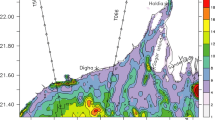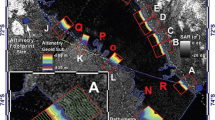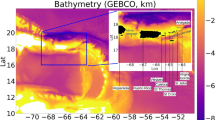Abstract
A numerical study using a 3-D nonhydrostatic model has been applied to baroclinic processes generated by the K 1 tidal flow in and around the Kuril Straits. The result shows that large-amplitude unsteady lee waves are generated and cause intense diapycnal mixing all along the Kuril Island Chain to levels of a maximum diapycnal diffusivity exceeding 103 cm2s−1. Significant water transformation by the vigorous mixing in shallow regions produces the distinct density and potential vorticity (PV) fronts along the Island Chain. The pinched-off eddies that arise and move away from the fronts have the ability to transport a large amount of mixed water (∼14 Sv) to the offshore regions, roughly half being directed to the North Pacific. These features are consistent with recent satellite imagery and in-situ observations, suggesting that diapycnal mixing within the vicinity of the Kuril Islands has a greater impact than was previously supposed on the Okhotsk Sea and the North Pacific. To examine this influence of tidal processes at the Kurils on circulations in the neighboring two basins, another numerical experiment was conducted using an ocean general circulation model with inclusion of tidal mixing along the islands, which gives a better representation of the Okhotsk Sea Mode Water than in the case without the tidal mixing. This is mainly attributed to the added effect of a significant upward salt flux into the surface layer due to tidal mixing in the Kuril Straits, which is subsequently transported to the interior region of the Okhotsk Sea. With a saline flux into the surface layer, cooling in winter in the northern part of the Okhotsk Sea can produce heavier water and thus enhance subduction, which is capable of reproducing a realistic Okhotsk Sea Mode Water. The associated low PV flux from the Kuril Straits to the open North Pacific excites the 2nd baroclinic-mode Kelvin and Rossby waves in addition to the 1st mode. Interestingly, the meridional overturning in the North Pacific is strengthened as a result of the dynamical adjustment caused by these waves, leading to a more realistic reproduction of the North Pacific Intermediate Water (NPIW) than in the case without tidal mixing. Accordingly, the joint effect of tidally-induced transport and transformation dominating in the Kuril Straits and subsequent eddy-transport is considered to play an important role in the ventilation of both the Okhotsk Sea and the North Pacific Ocean.
Similar content being viewed by others
References
Alfultis, M. A. and S. Martin (1987): Satellite passive microwave studies of the Sea of Okhotsk Sea ice cover and its relation to oceanic processes. J. Geophys. Res., 92, 13,013–13,028.
Aramaki, T., S. Watanabe, T. Kuji and M. Wakatsuchi (2001): The Okhotsk-Pacific seawater exchange in the viewpoint of vertical profiles of radiocarbon around the Bussol' Strait. Geophys. Res. Lett., 28, 3971–3974.
Awaji, T., S. Masuda, Y. Ishikawa, N. Sugiura, T. Toyoda and T. Nakamura (2003): State estimation of the North Pacific Ocean by a four-dimensional variational data assimilation. J. Oceanogr., 59, 931–943.
Favorite, F., A. J. Dodimead and K. Nasu (1976): Oceanography of the Subarctic Pacific region, 1960-1971. Bull. Int. North Pac. Fish. Comm., 33, 187 pp.
Fine, R. A., K. A. Maillet, K. F. Sullivan and D. Willey (2001): Circulation and ventilation flux of the Pacific Ocean. J. Geophsy. Res., 106, 22,159–22,178.
Freeland, H. J., A. S. Bychkov, F. Whitney, C. Taylor, C. S. Wong and G. I. Yurasov (1998): WOCE section P1W in the Sea of Okhotsk 1. Oceanographic data description. J. Geophsy. Res., 103, 15,613–15,623.
Gent, P. R. and J. C. McWilliams (1990): Isopycnal mixing in ocean circulation models. J. Phys. Oceanogr., 20, 150–155.
Gladyshev, S. V. (1995): Fronts in the Kuril Island region. Oceanology, English translation, 34, 452–459.
Gladyshev, S., S. Martin, S. Riser and A. Figurkin (2000): Dense water production on the northern Okhotsk shelves: Comparison of ship-based spring-summer observations for 1996 and 1997 with satellite observations. J. Geophys. Res., 105, 26,281–26,299.
Goodman, P. J. (2001): Thermohaline adjustment and advection in an OGCM. J. Phys. Oceanogr., 31, 1477–1497.
Gregg, M. C. (1989): Scaling turbulent dissipation in the thermocline. J. Geophys. Res., 94, 9686–9698.
Griffies, S. M., A. Gnanadesikan, R. C. Pacanowski, V. D. Larichev, J. K. Dukowicz and R. D. Smith (1998): Isoneutral diffusion in a z-coordinate ocean model. J. Phys. Oceanogr., 28, 805–830.
Hasumi, H. and N. Suginohara (1999): Sensitivity of a global ocean general circulation model to tracer advection schemes. J. Phys. Oceanogr., 29, 2730–2740.
Huang, R. X. and S. Russell (1994): Ventilation of the Subtropical North Pacific. J. Phys. Oceanogr., 24, 2589–2605.
Ikeda, M. (1989a): A coupled ice-ocean mixed layer model of the marginal ice zone to wind forcing. J. Geophys. Res., 94, 9699–9709.
Ikeda, M. (1989b): Snow cover detected by diurnal warming of sea ice/snow surface off Labrador in NOAA imagery. IEEE Trans. Geosci. Remote Sens., 27, 552–560.
Ishikawa, Y., T. Awaji, T. Toyoda and N. Komori (2002): Construction of a data assimilation system for ocean general circulations-Determination of weight parameters for the adjoint method-. Proc. of Int. Simposium "En route to GODAE", B09-21, Biarritz, France.
Itoh, M., Y. Kawasaki, K. I. Ohshima, G. Mizuta, Y. Fukamachi and M. Wakatsuchi (2002): Anticyclonic eddies in the Okhotsk Sea. Eos. Trans. AGU, 83(4), Ocean Sciences Meet. Suppl., Abstract, OS11C-53.
Kawasaki, Y. (1996): The origin of the North Pacific Intermediate Water-from the observations in the Okhotsk Sea-. Kaiyo Monthly, 28, 545–552 (in Japanese).
Kawasaki, Y. and T. Kono (1994): Distribution and transport of Subarctic Waters around the middle of Kuril Islands. Umi to Sora, 70, 71–84 (in Japanese with English abstract and figure captions).
Kawase, M. (1987): Establishment of deep ocean circulation driven by deep-water production. J. Phys. Oceanogr., 17, 2294–2317.
Kitani, K. (1973): An oceanographic study of the Okhotsk Sea-particularly in regard to cold waters. Bulletin of the Far Seas Fisheries Research Laboratory, 9, 45–77.
Kono, T. (1998): Formation of the salinity minimum in the Mixed Water Region between the Oyashio and Kuroshio Fronts. Deep-Sea Res. I, 45, 2035–2057.
Kono, T. and Y. Kawasaki (1997): Result of CTD and mooring observations southeast of Hokkaido. 2, Annual variations of water mass structure and salt flux of the Oyashio. Bull. Hokkaido Natl. Fish. Res. Inst., 61, 83–95.
Levitus, S. and T. P. Boyer (1994): World Ocean Atlas 1994, Vol. 4, Temperature. NOAA Atlas NESDIS 4, U.S. Govt. Printing Office, Washington, D.C., 117 pp.
Levitus, S., R. Burgett and T. P. Boyer (1994): World Ocean Atlas 1994, Vol. 3, Salinity. NOAA Atlas NESDIS 3, U.S. Govt. Printing Office, Washington, D.C., 99 pp.
Martin, S., R. Drucker and K. Yamashita (1998): The production of ice and dense shelf water in the Okhotsk Sea polynyas. J. Geophys. Res., 103, 27,771–27,782.
Miura T., T. Suga and K. Hanawa (2002): Winter mixed layer and formation of dichothermal water in the Bering Sea. J. Oceanogr., 58, 815–823.
Nakamura, T. and T. Awaji (2001): A growth mechanism for topographic internal waves generated by an oscillatory flow. J. Phys. Oceanogr., 31, 2511–2524.
Nakamura, T. and T. Awaji (2003): Tidally-induced diapycnal mixing in the Kuril Straits and its roles in water transformation and transport: A three dimensional nonhydrostatic model experiment. J. Geophys. Res. (submitted).
Nakamura, T., T. Awaji, T. Hatayama, K. Akitomo and T. Takizawa (2000a): Tidal exchange through the Kuril Straits. J. Phys. Oceanogr., 30, 1622–1644.
Nakamura, T., T. Awaji, T. Hatayama, K. Akitomo, T. Takizawa, T. Kono, Y. Kawasaki and M. Fukasawa (2000b): The generation of large-amplitude unsteady lee waves by subinertial K1 tidal flow: a possible vertical mixing mechanism in the Kuril Straits. J. Phys. Oceanogr., 30, 1601–1621.
Noh, Y. and H. J. Kim (1999): Simulations of temperature and turbulence structure of the oceanic boundary layer with the improved near-surface process. J. Geophys. Res., 104, 15,621–15,634.
Ohshima, K. I., M. Wakatsuchi, Y. Fukamachi and G. Mizuta (2002): Near-surface circulation and tidal currents of the Okhotsk Sea observed with the satellite-tracked drifters. J. Geophys. Res., 107, art. no. 3195.
Ohtani, K. (1989): The role of the Sea of Okhotsk on the formation of the Oyashio water. Umi to Sora, 65, 63–83 (in Japanese with English abstract and figure captions).
Pedlosky, J. (1987): Geophysical Fluid Dynamics. 2nd ed., Springer-Verlag, New York, 710 pp.
Pedlosky, J. (1996): Ocean Circulation Theory. Springer-Verlag, Berlin, Heidelberg, 453 pp.
Reid, J. L. (1973): North Pacific Ocean Waters in Winter. The Johns Hopkins Press, Baltimore, 85 pp.
Röske, F. (2001): An atlas of surface fluxes based on the ECMWF re-analysis-a climatological dataset of force global ocean general circulation models. Max-Planck-Institut f? u Meteorologie, 323, 26 pp.
Talley, L. D. (1991): An Okhotsk Sea water anomaly: implications for ventilation in the North Pacific. Deep-Sea Res., 38, S171–S190.
Talley, L. D. (1993): Distribution and formation of North Pacific Intermediate Water. J. Phys. Oceanogr., 23, 517–537.
Talley, L. D. and J. Y. Yun (2001): The role of cabbeling and double diffusion in setting the density of the North Pacific intermediate water salinity minimum. J. Phys. Oceanogr., 31, 1538–1549.
Talley, L. D., Y. Nagata, M. Fujimura, T. Iwao, T. Kono, D. Inagake, M. Hirai and K. Okuda (1995): North Pacific Intermediate Water in the Kuroshio/Oyashio Mixed Water Region. J. Phys. Oceanogr., 25, 475–501.
Tanaka, K. and K. Akitomo (2001): Baroclinic instability of density current along a sloping bottom and the associated transport process. J. Geophys. Res., 106, 2621–2638.
Thomson, R. E., P. H. LeBlond and A. B. Rabinovich (1997): Oceanic odyssey of a satellite-tracked drifter: North Pacific variability delineated by a single drifter trajectory. J. Oceanogr., 53, 81–87.
Tsunogai, S., T. Ono and S. Watanabe (1993): Increase in total carbonate in the western North Pacific water and a hypothesis on the missing sink of anthropogenic carbon. J. Oceanogr., 49, 305–315.
Ueno, H. and I. Yasuda (2000): Distribution and formation of the mesothermal structure (temperature inversions) in the North Pacific subarctic region. J. Geophys. Res., 105, 16,885–16897.
Van Scoy, K. A., D. B. Olson and R. A. Fine (1991): Ventilation of North Pacific Intermediate Waters: The role of the Alaskan Gyre. J. Geophys. Res., 96, 16,801–16,810.
Warner, M. J., J. L. Bullister, D. P. Wisegraver, R. H. Gammon and R. F. Weiss (1996): Basin-wide distributions of chlorofluorocarbons CFC-11 and CFC-12 in the North Pacific. J. Geophys. Res., 101, 20,525–20,542.
Watanabe, T. and M. Wakatsuchi (1998): Formation of 26.8 ?? water in the Kuril Basin of the Sea of Okhotsk as a possible origin of North Pacific Intermediate Water. J. Geophys. Res., 103, 2849–2865.
Watanabe, Y., K. Harada and K. Ishikawa (1994): Chlorofluorocarbons in the central North Pacific and southward spreading time of North Pacific intermediate water. J. Geophys. Res., 99, 25,195–25,213.
Wong, C. S., R. J. Matear, H. J. Freeland, F. A. Whitney and A. S. Bychkov (1998): WOCE line P1W in the Sea of Okhotsk 2. CFCs and the formation rate of intermediate water. J. Geophys. Res., 103, 15,625–15,642.
Yamanaka, Y. and E. Tajika (1996): The role of the vertical fluxes of particulate organic matter and calcite in the oceanic carbon cycle: Studies using biogeochemical general circulation model. Global Biogeochem. Cycles, 10, 361–382.
Yasuda, I. (1997): The origin of the North Pacific intermediate water. J. Geophys. Res., 102, 893–910.
Yasuoka, T. (1968): Hydrography in the Okhotsk Sea-(2). The Oceanographical Magazine, 20, 55–63.
You, Y., N. Suginohara, M. Fukasawa, I. Yasuda, I. Kaneko, H. Yoritaka and M. Kawamiya (2000): Roles of the Okhotsk Sea and Gulf of Alaska in forming the North Pacific Intermediate Water. J. Geophys. Res., 105, 3253–3280.
Author information
Authors and Affiliations
Rights and permissions
About this article
Cite this article
Nakamura, T., Toyoda, T., Ishikawa, Y. et al. Tidal Mixing in the Kuril Straits and Its Impact on Ventilation in the North Pacific Ocean. Journal of Oceanography 60, 411–423 (2004). https://doi.org/10.1023/B:JOCE.0000038225.15056.c6
Issue Date:
DOI: https://doi.org/10.1023/B:JOCE.0000038225.15056.c6




